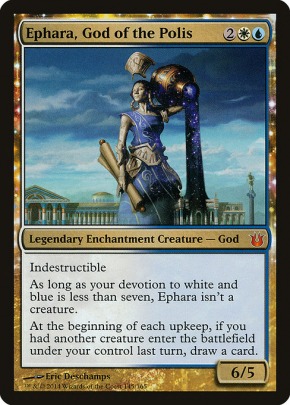If I had to give only one number to the three decks I have on a permanent basis right now, it would be a 6 for Aminatou, 6 for Omnath, and 4 for Niv-Mizzet Reborn. This is all largely by design rather than lack of available budget or cards. I like to win, but I also like to tell stories, and an epic struggle to me is better than a Mike-and-Trike plaster.cryogen wrote: ↑4 years ago"Casual"
"Competitive"
"A 7"
There is a lot of discussion surrounding how we determine the power level of our decks in order to better facilitate Rule 0. But what actually goes into that decision? By what metrics do you personally use to reach a decision on the power level of your deck?
Some considerations you might have:
How fast does your deck intend to win?
How consistent is your deck?
How important is winning to you when you play?
How well can your deck interact with your opponents, and is it capable of disrupting their potential win?
As a follow up question, what sort of things would be included in your ideal scale in order to find your ideal category and best matchup?
Now, if I had to give them a range of numbers, Aminatou could be 6-7, Omnath 6-7 maybe 8, and Niv 4-5. I'd increase each because Aminatou she CAN combo out turn 4, but it has to be a native draw, though she has some bad tutors and a few backup combos. Omnath can go 0-60 in a turn or two, so it can be quite explosive, though no combos to win right-off (Strong synergies, though), and struggles without being able to deal damage. Niv is a personal challenge where it has all gold cards excluding lands and Chromatic Lantern. It's quite fun (though Boros doesn't contribute much), but besides some synergies so far it's nothing to be afraid of, and lacks any interaction at instant speed besides some charms and a few removal spells.
For me, rating decks has a lot to do with interaction and at what speed / how much does it interact with. If you're just slamming behemoths onto the field and attacking, then I'd rate it lower overall because 1-3 wipes and you're poop (I play in a group with a lot of mass removal, so that informs my opinion here). If you add some recursion and therefor pressure, it goes up a notch or two. Back in the day, my Tariel deck never lost (except that one time where I intentionally walked into a losing battle for a friend), but the games took 2 fudging hours minimum. Back then I'd rate it a solid 7 since it was lands, mana rocks, mass removal, and creatures that did stuff. These days if it was around I'd say it's a solid 5 because of the introduction of new cards to fight that kind of strategy, or mitigate it.
By and large, I've strived away from any competitive deck, with Aminatou being the closest I'm willing to go. Just not how I like to have fun, but I don't hold it against anyone who does. Just don't use it three games in a row please (I recently learned why Brago is competitive the hard way XD)





 Zacama
Zacama


